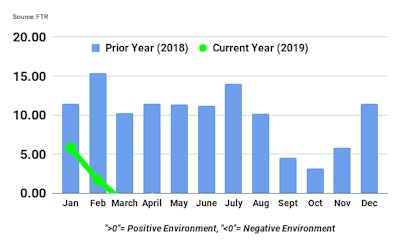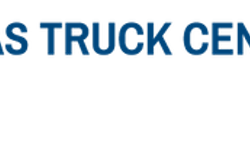New reports out this week from ACT Research and FTR show the trucking industry took another step closer to an inevitable downswing last month, burying the market’s strong 2018 further in the rearview mirror.
On Monday, ACT Research published its latest North American Commercial Vehicle Outlook release in which it reported that despite upside in the 2019 build forecast, large new truck inventories and deteriorating freight and rate conditions show reasons for the industry to be cautious as it enters the second half of the year.
ACT Vice President Steve Tam says for more than a year his company has been forecasting the third quarter of 2019 as the tipping point that would break the current period of peak vehicle production. After a bumpy May, he says, “Current data and anecdotes make a strong case that the call for a Q3 inflection point expectation remains intact.”
This news was followed Wednesday by FTR’s latest Trucking Conditions Index report. FTR notes its index as actually climbed last month, but remains a -0.64 reading “as the rate environment continues to soften.” FTR says it expects the index will remain in a narrow band of negative readings through 2019 and into the 2020 calendar year.
“Not that long ago, it seemed inconceivable that the good times in trucking would end, but here we are back down to earth,” says Avery Vise, FTR vice president, trucking. “Growth in manufacturing – the most significant driver of trucking activity – has subsided, and residential construction remains stagnant.
 Not pictured: Negative readings for April (-1.18) and May (-0.64).
Not pictured: Negative readings for April (-1.18) and May (-0.64).“However, there are some near-term positives, such as lower diesel prices. Also, carriers are responding to flagging demand by ending their hiring spree, which could set the stage for firmer capacity utilization down the road.”
While both firms carefully avoided using that r-word that comes on the downswing of economic cycles and the current business climate remains generally stable, it has become clear that the next six to 12 months could be lean for the dealer channel. Falling truck orders can be managed when build rates are high, when both fall in conjunction the market feels it. Additionally, Vise’s comment about firmer capacity utilization seems like a short-term positive that could become a longer-term negative. Once carriers stop adding drivers, they’re unlikely to add many more new or used vehicles.
If there is good news to take from this news, it’s this — what’s coming isn’t a new occurrence, nor is it likely to harm the back end of your business like it’s going to weaken your front end.
Regarding the former, Tam notes “carrier profitability and production peaks always lag the freight cycle, so capacity building always accelerates relative to freight growth at exactly the wrong time. Hence, cycle duration ultimately comes down to timing and excluding the pre-buy and housing bubble impacted 2004-2006 cycle, peak of cycle build rates has historically lasted between 13 and 15 months. For this Class 8 cycle, we date peak build rates to June 2018, so we are currently in 12 months.”
As for the latter point, while weakening freight totals are worrisome, general prognostications about the U.S. and North American economy remain mildly optimistic through 2020.
Speaking at Heavy Duty Aftermarket Dialogue in January, Bill Strauss of the Chicago Federal Reserve told attendees that the U.S. economy slightly exceeded expectations with 3 percent GDP growth last year and is trending toward more of the same with greater than 2 percent growth anticipated through 2021. That growth prediction has been confirmed multiple times in recent months. And while trade disputes between the U.S. and China and U.S. and Mexico have create confusion and uncertainty among industry suppliers, the stock market and economists at large, their overall impact on the retail economy has been minimal. Whether because of the trade negotiations or in spite of them, the U.S. economy remains steady.
So while it’s becoming increasingly clear that new truck sales have started back down the other side of the mountain, I think there’s reason to believe the slowdown coming to our industry shouldn’t be devastating. Competition in the parts and service space will likely increase, but whether you’re a dealer shifting your focus or an independent aftermarket business managing new competition, I think the businesses with the clearest understanding of their customer base and regional economy will remain strong. A pause on equipment purchasing doesn’t mean the market is contracting, just that’s it no longer on expanding. We would need a full scale economic downturn for that.











